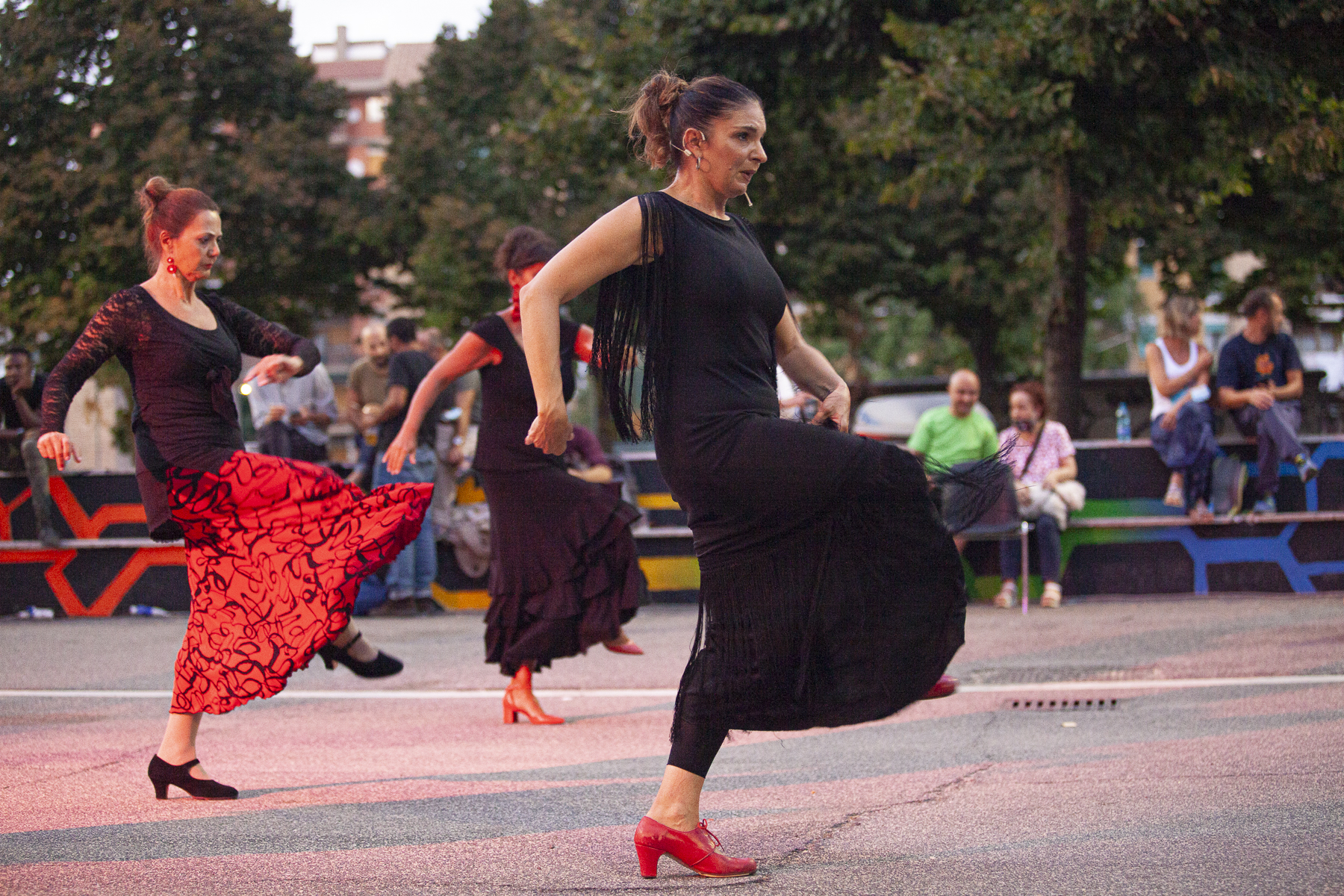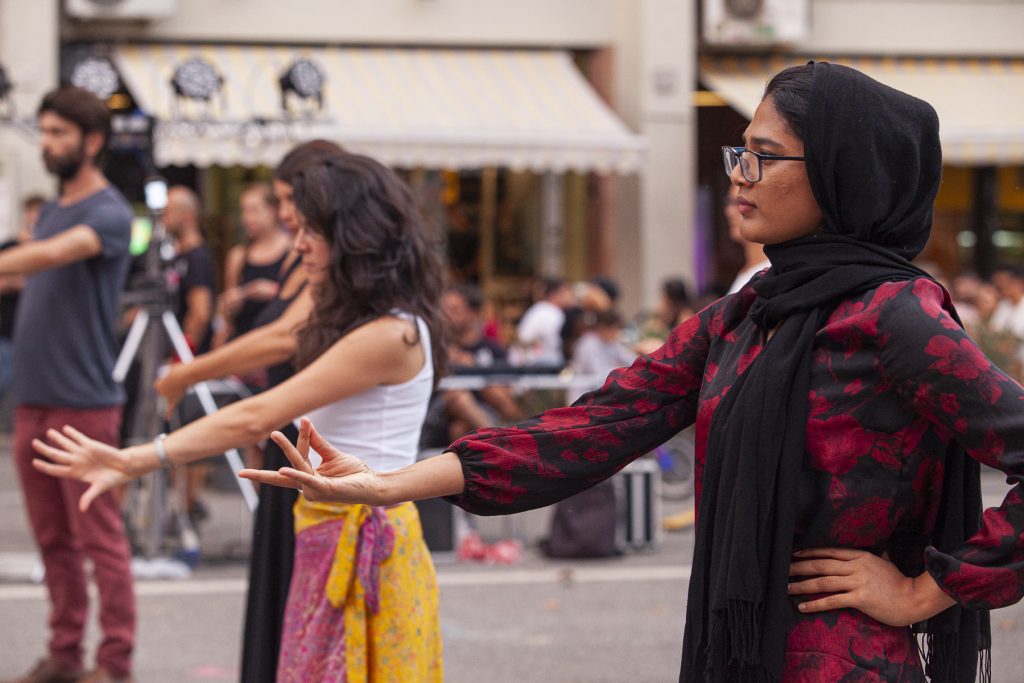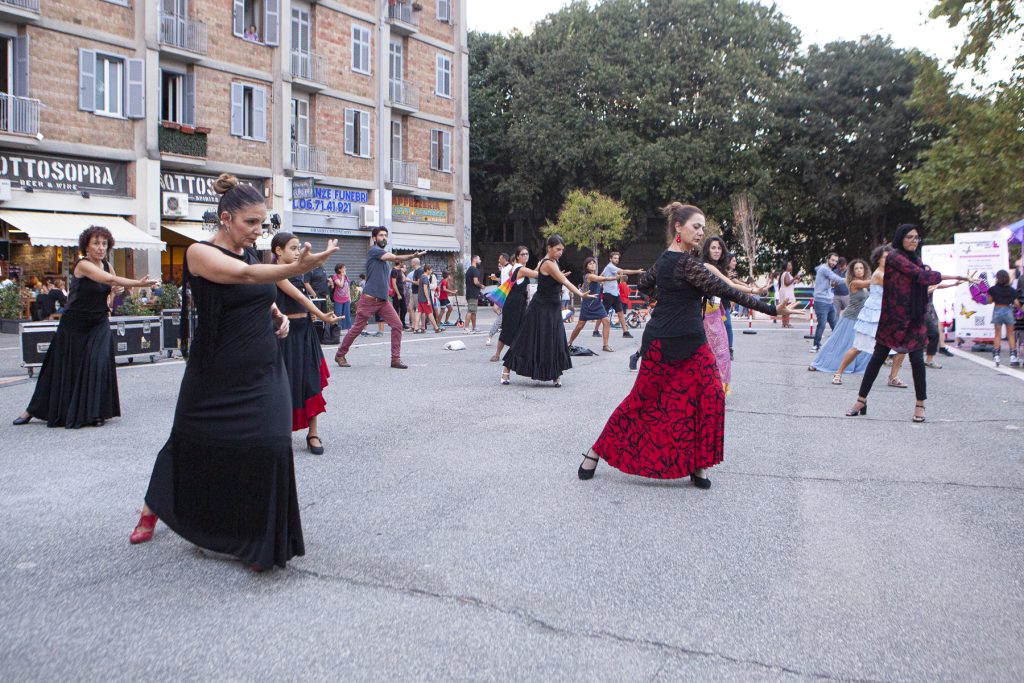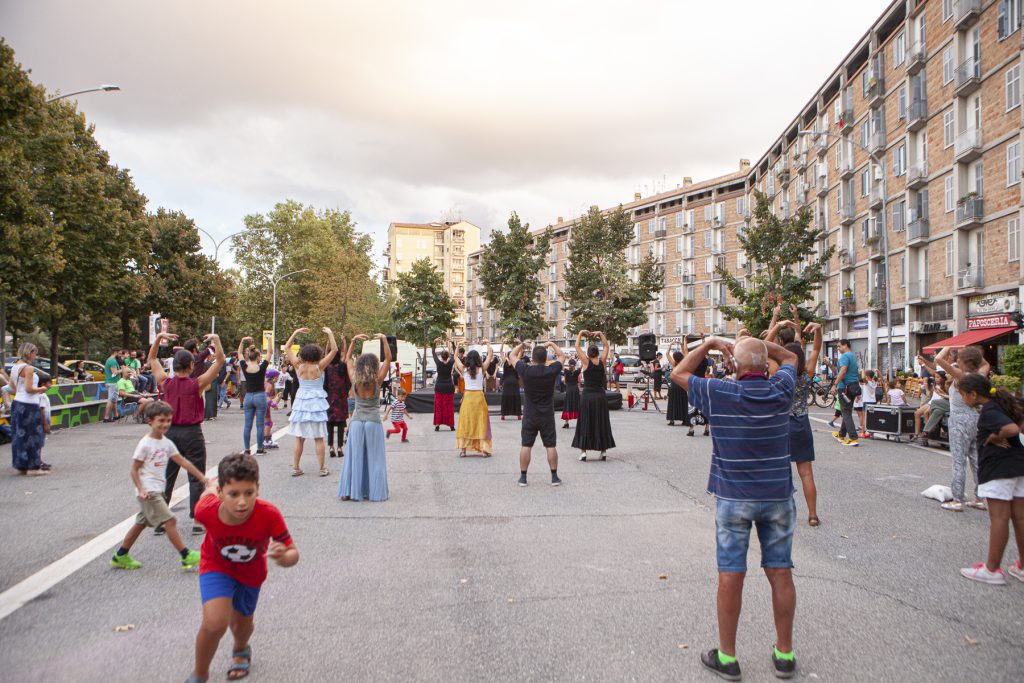Clicca qui per l’articolo in italiano sul blog del festival Attraversamenti Multipli
by Federica Mezza, Naiva Mbongobou, Nour Zarafi English translation by Velia Cimino

photo Carolina Farina
On Sunday afternoon, Largo Spartaco square was flooded with dancers wearing chignons, wide skirts and heels. Giorgia Celli took us on a dancing journey through Andalusia, introducing us to the first steps of flamenco in her open Flamenco for All lesson for Attraversamenti Multipli 2021. Chiara, Prity, Naiva and I, together with other RE.M boys and girls, immediately poured into the mirrorless ballroom that was now Largo Spartaco. We arranged ourselves in rows behind Giorgia Celli, who was standing with her back facing us in her long, tight-fitting black dress adorned with thin silk fringes. Then she climbed onto a small wooden platform: ‘Not because I’m the teacher’, she said, ‘but because you can hear me better this way’. What we had to hear were the ground strokes done with her heeled shoes. “We are dancers and also musicians”, she said right away “Flamenco is a special dance because it is the result of contamination; There is ballet, for the precision and clearness of its movements; Arabic dance, for the sensuality and sinuosity of its gestures; moreover, it embraces Gypsy traditions. In flamenco, the most important thing is to keep up with the rhythm,” she explained, “we are percussionists because we play music using our bodies: we tap our feet, sometimes with the heel, sometimes with the whole sole, sometimes ‘kicking’ backwards, with our hands and on our legs…”.

photo Carolina Farina
First, we begin warming up: a mixed group of people, in terms of gender and age, made up of strangers dressed in not entirely suitable clothes for this kind of dance, starts imitating the teacher by loosening their shoulders, necks and even their fingers in slow, well-paced movements.
One of the most important aspects of the dance is the precision and firmness of the movements. Giorgia Celli led us through the dance step by step (literally), setting the pace in a mixture of Italian and Spanish, from the bow of the microphone that she dropped at every tres, the moment when we had to make a slightly haughty head turn to the right.
It takes some courage to show yourself while learning something new. You show how fragile and uncoordinated you are and you reveal your vulnerability. But judging eyes are not important; it is not a matter of precision of the steps, rather one’ s connection with music. Accompanying us throughout this challenge were the cantaores with their instruments, guitar and percussion, who added a special dimension to the flamenco lesson. Celli invited us to bring intention and spirit into our movements, the famous duende, which gives life to a dance. How could it be otherwise? And how much duende does it take? Surely it is essential to feel the tension that moves us, a force that pulses from within and releases energy. As with all folk dances, which are about earth and a communitary dimension, it is an urgency that has to be released and cannot wait, in a sort of emotional rapture. Naiva, a student at the Asinitas Italian school, and I exchanged a few impressions.

photo Carolina Farina
She told me: “In my country, in Congo, I have always danced. In Africa, dancing is constantly part of people’s lives: when you are sad, you dance, when you are happy, you dance, just like when you have a party or any important celebration. It helps you express your emotions. In Congo I attended zumba classes and then, during the lockdown, when I was in Ghana, I started giving small outdoor classes to my friends. It’s something you do, teachers bring music and people dance in the square. Passers-by can stay and join in. Zumba in Africa is very different from what I’ve seen here, what I’ve been practicing is afro zumba, based on African music. I really enjoyed this flamenco class – the teacher is really good. I experienced something different from the ones I come from, I had only seen flamenco on television but I had never practised it. At the beginning I was a bit embarrassed, I was the only African. When something like that happens, I feel like all the attention is on me, which makes me uncomfortable because I don’t like being looked at. Plus, I am very tall. But after a while I didn’t think about it any more and I had fun.

photo Carolina Farina
We also interviewed Nour, a member of the editorial staff, who observed the event as a spectator: “I chose to stand outside watching what was going on; I was reminded of the first time I discovered flamenco, when I saw Tony Gatlif’s film Vengo. I vividly remember the melody and rhythm of the first sequence, the fusion of Andalusian and Arabic music, a dialogue between flamenco and Sufic dance, it really was like a cinema class for me beyond the world of Flamenco. This bodily expression, in which I perceive both anger and joy, is a ride on a rollercoaster of alternating emotions. On Sunday I could see different bodies: the charismatic and authoritarian teacher, the uncertain participants and a drunk in the square.
I appreciated their flexibility in keeping up with the rhythm, their steps, their tempo and sound. It wasn’t all perfect though, the teacher insisted on being assertive in tapping your feet and elegant in your hand movements. I watched for about half an hour and felt the urge to jump in and dance like them. The light, the music, the square and the people were like a very welcoming cityscape allowing everyone to celebrate all each in their own way. An impromptu party, with no major planning, a very spontaneous happening.
We say goodbye with applause and free dancing. Last scene on which my gaze lingers is of a little girl in sandals and shorts fascinated by Giorgia Celli’s steps who, having noticed to be the object of wonder of a four-year-old girl, dances provokingly around her, showing off her percussionist-dancer shoes.
Federica Mezza, Naiva Mbongobou, Nour Zarafi

This website is one of the final products of the project “LiteracyAct – Basic literacy, transversal skills and competences for adult migrants”, Erasmus Plus KA2 Adult Education N.2020-1-IT02-KA204-080084
Disclaimer
The European Commission support for the production of this publication does not constitute an endorsement of the contents which reflects the views only of the authors, and the Commission cannot be held responsible for any use which may be made of the information contained therein